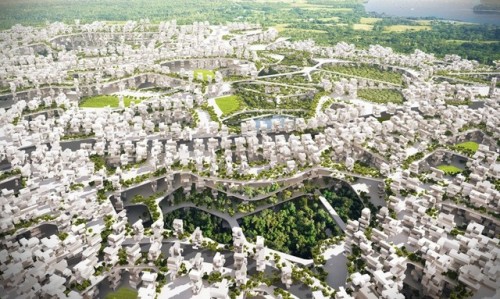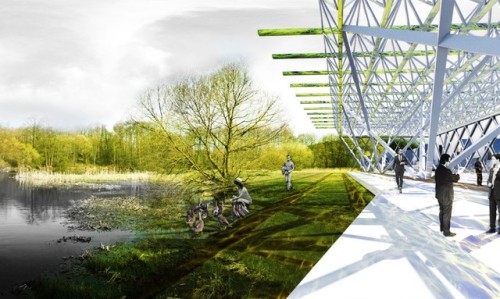#greenhouse gas emissions
Liberland could become the world’s first algae-powered city
Back in 2015, a group of disillusioned Czech citizens had this idea that they would secede from the nation and form their own sovereign state: the Republic of Liberland. The small 2.7 square mile site lies between Croatia and Serbia, right over a flood plain of the river Danube.
Several thousand people have since applied for citizenship in the tiny nation, with proposals for the design of the state open to those who dared submit a proposal. In the end it was RAW-NYC who came up with the winning idea; a stacked city of self-sustained blocks would gradually build upwards and outwards from an initial set in what the designers call “Inverted Archeology”.
The city would be pedestrian-friendly, and the unique stacked design would allow for buildings to be placed much closer together than traditional construction would allow. Buildings would be like skyscrapers put on their sides; built in layers and accessible to everyone at all levels rather than simply at the ground lobby as traditional towers would be. These would also be meticulously planned to allow natural light to penetrate all accessible spaces.
To mitigate greenhouse gases created by such a dense urban environment, algae strains that do not require sunlight to grow would be housed on the undersides of the buildings in a vast underground habitat; providing clean energy.
See more at: Inhabitat
Post link
https://www.ecowatch.com/new-zealand-livestock-methane-emissions.html
New Zealand Considers Charging Farmers for Livestock Emissions - EcoWatch
In New Zealand, sheep and cattle outnumber people. All that livestock passes gas, which means emitting more methane into the atmosphere. As such, the country has proposed to tax farmers for their livestock’s emissions.
New Zealand’s agriculture makes up almost half of the country’s greenhouse gas emissions. According to the BBC, there are about 5 million people in New Zealand, but there are 10 million cattle and more than 26 million sheep. Although New Zealand has an emissions trading scheme in place to minimize climate change, the agriculture industry was not included.
“We need to urgently cut emissions across all sectors of the economy – and that includes agriculture,” Climate Change Minister James Shaw said in a statement. “There is no question that we need to cut the amount of methane we are putting into the atmosphere, and an effective emissions pricing system for agriculture will play a key part in how we achieve that.”
The proposal includes incentives for farmers to cut emissions. For example, they may add seaweed to livestock feed to help reduce the amount of methane the livestock produce. Farmers can also plant trees to help offset their emissions.
New Zealand currently has a goal to reduce methane emissions from agriculture by 24% to 27% by 2050 and is set to decide on the proposal in December 2022. In the meantime, the government and farmers have more details to hammer out if they plan to move forward with this scheme. The agriculture industry and the public will also have opportunities to share their views on the proposal.







